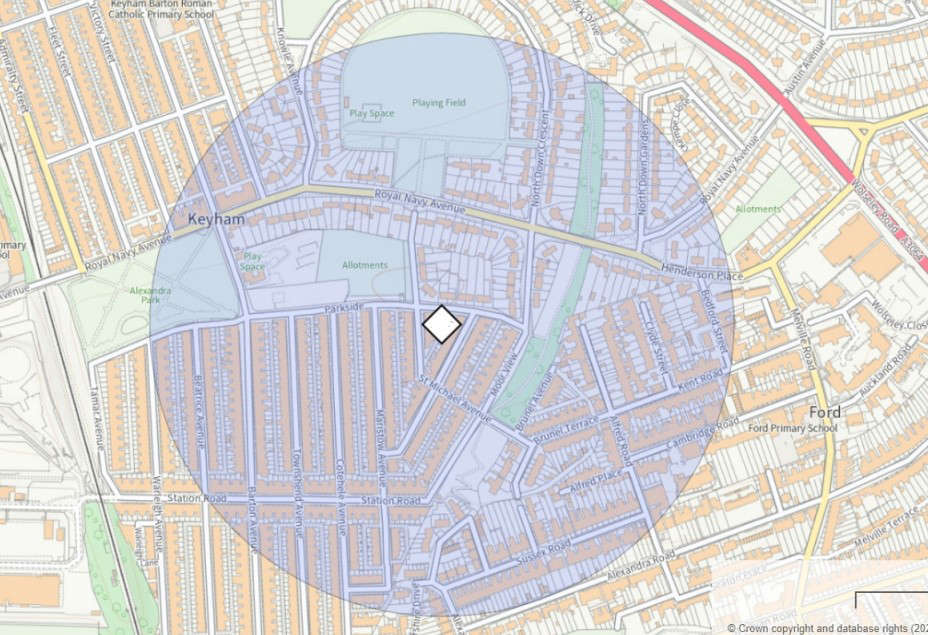
3000 residents have left their homes
More than 3,000 people have left their homes after an unexploded Second World War bomb was found in the back garden of a home in Plymouth.
Devon and Cornwall Police declared a major incident on Tuesday and evacuated properties within 200 metres of the bomb, extending it to 309 metres on Thursday.
Plymouth Council has confirmed bomb disposal experts from the army and navy plan to dispose of the bomb today - but how will they do it?
Here's everything we know about the bomb and what's being done to remove it - plus expertise from a bomb disposal expert.
What do we know about the bomb?
The bomb, which can also be referred to as an unexploded ordnance (UO), is a 500kg (1,102lb) German bomb from the Second World War, a Ministry of Defence (MoD) spokesperson has said.
The MoD identified it as a SC500 transverse fuzed airdrop weapon which, according to the Luftwaffe Resource Centre's website, was a "general demolition bomb".
It's the same type of bomb that was found off the north coast of Guernsey in July 2023 by a local diver. The Royal Navy carried out a controlled explosion on the Guernsey bomb within an hour of specialist divers going to see it for the first time.
Andy Abbott, who spent 25 years in the Army Reserve's bomb unit, told Sky News it was one of the biggest types of bombs the Germans dropped during the war that still get found today.
Where is the bomb and how was it found?
Officers were first called to a property on St Michael Avenue in Keyham on Tuesday, after a man reported finding the device while digging out the foundations for an extension in the garden.
Speaking to Plymouth Live, the man who called police said he actually found it "about a week ago".
He said he "hit something with a spade, but we weren't sure what it was at first".
He said rain over the next few days made the object increasingly visible.
The man called the police on Tuesday and sent them photos.
"Five minutes later there's a knock on the door and police officers asking to have a look," he said. "The next minute they're suggesting a cordon."
Mr Abbott said bombs such as this one are usually found in big fields or in docks rather than more confined places such as the Keyham garden.
Who is dealing with it? And could it explode?
It was Devon and Cornwall Police who first came to the scene, but since then there has been the Royal Navy's bomb disposal unit, military personnel and service members of various search and rescue teams, including from the local fire brigade.
Plymouth Council said the bomb would be removed and transported by military convoy through the city for disposal at sea.
In a statement, the council said the bomb disposal experts considered a controlled detonation on site, but ultimately decided "the safest and least impactful option is to remove the device from St Michael Avenue and travel to the Torpoint Ferry slipway - for the bomb to be disposed of at sea (beyond the Breakwater)".
"Highly trained bomb disposal experts will carefully remove the device from the property and it will be transported by road in a military convoy, west along Parkside and Royal Navy Avenue, joining at the junction on Saltash Road to continue south joining Albert Road, turning right along Park Avenue and heading down Ferry Road to the Torpoint Ferry terminal," the statement said.
Mr Abbott says "the best option is to always blow it up in situ", but added the squad would have weighed up the damage that could be done to nearby houses and infrastructure.
When it comes to moving it "there is a risk, but it's a minimal risk," he added. "They wouldn't be going with this process if they hadn't weighed up the odds and found that it was pretty safe. But it is a big one, and there's obviously always a slight risk."
Explaining the process, he said: "They'll probably lift the bomb onto the back of a truck, most likely with a crane.
"You protect it as much as you can on the back of the truck, probably by burying it in loads of sandbags, then they'll gradually move it with a police cordon in place down to the sea."
Images on Thursday showed tonnes of sand being delivered to the area, which a police source told Plymouth Live would be used to build a sand wall around the unexploded bomb.
Mr Abbott said sand and water bags are often used to mitigate for the bomb going off and that the bomb squad would have weighed up detonating the bomb on site, using them to contain the explosion.
"But you're probably going to be blowing up four or five houses at least," he said. "Even if you try and mitigate the explosion, the damage to those properties… they would be knocked down."
Royal Naval Bomb Disposal experts dug around the explosive and used a special device to assess it.
A team of 200 volunteers from some of the organisations mentioned above have been visiting houses in the Keyham area, checking that the necessary homes have been evacuated and offering information to local residents.
Why not just diffuse it?
Mr Abbott says that while a fuse as old as the ones in a WW2 bomb are unlikely to be dangerous, there is a type of explosive acid often built into them which may cause problems while trying to diffuse it.
"Obviously the device is very old now. The fusion system they used on these were two fuses that transverse in the bomb itself," he explained.
"So you'd have to mitigate the fusing. And by now, after this time, the fuses would be quite safe. The only issue you might have is sometimes these things were filled with picric acid, so you'd have picric crystals that can form after leaking and that is dangerous.
"So if you try and remove the fuse or take the fuse out that way, that could have the same effect as the fuse actually working. So you need to mitigate the risk of that too."
How many people have been evacuated and when can they go back?
The cordon has meant 1,219 properties have been affected and an estimated 3,250 people have had to leave the area this week, with residents encouraged to stay with friends and family.
Those who have been evacuated have only been allowed to return to their homes to collect "urgent, essential items only" including medication or a pet, the council added.
But now residents of the Devon city living within 300 metres of the convoy route will need to completely evacuate their home between the hours of 2pm and 5pm this afternoon.
The council said it would "aim to keep residents informed throughout the operation" and that it would announce when roads are being reopened on its website and on social media.
Plymouth's Life Centre has been set up as an emergency rest centre with tea and coffee, blankets, towels and toothbrushes, a creche and faith room available.
A similar incident to this one occurred in Plymouth in 2011, when an explosive device was unearthed by a workman at a building in Notte Street, near the city's Hoe.
The device was made safe before it was moved to the seabed off Plymouth Sound, with an exclusion zone around it.
Plymouth saw more than 50 bombing attacks during the Second World War.

 Students connect with elderly residents to combat loneliness
Students connect with elderly residents to combat loneliness
 Crackdown on anti-social behaviour in Plymouth
Crackdown on anti-social behaviour in Plymouth
 £1.6 million for more energy efficiency Devon home upgrades
£1.6 million for more energy efficiency Devon home upgrades
 SWW to build huge new Churston solar farm
SWW to build huge new Churston solar farm
 MP highlights Devon's dentistry 'crisis'
MP highlights Devon's dentistry 'crisis'
